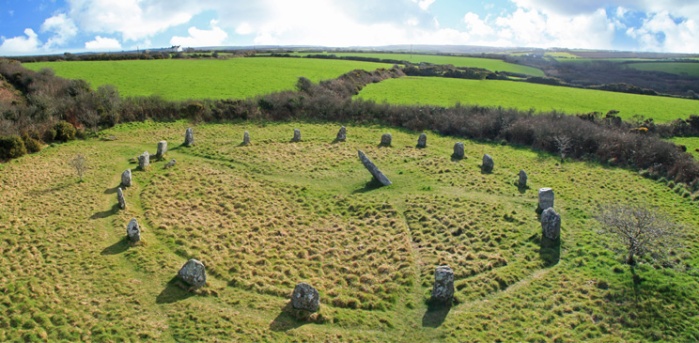
Whenever I visit Cornwall, and certainly whenever I am in the west of the county in Penwith, I try to visit the stone circle at Boscawen Un. It is- possibly- my favourite megalithic arrangement in the country (as I’ve mentioned before).
Although it’s a well known stone circle, the trick with Boscawen is to know where to stop on the main road that races past the site. There’s a pull-in large enough for two or three cars, but there’s next to no signposting and you have to be prepared (and ideally on the right side of the road) to be able to park. There are distinct advantages to this physical difficulty: it’s never too busy, which means that you get time to listen and to feel, to get to know the spirit of the place. As many readers will know, these sensations are rarely enjoyed at such great and accessible monuments as Avebury or Castlerigg. Splendid as these may be, ready access to coach parties kills the very experience that everyone (I assume) came for- by which I mean communing with the stones and the landscape, NOT taking selfies…
Having managed to park, then there’s a bit of a walk, past some rock outcrops, to the circle itself. The distance is perhaps a quarter of a mile downhill through the usual Cornish scrub of bracken, gorse and bramble. You’re offered a glimpse or two of the site, which sits in a small valley, but one of the beauties of Boscawen is that the circle lies within an enclosing Cornish hedge, the circumference of which is mostly topped with elder, hawthorn and other bushes. These particular shrubs are highly appropriate: hawthorn has supernatural associations, being widely known as the ‘fairy thorn’ (as demonstrated by poems of the same name by Samuel Ferguson and Dora Sigerson Shorter); elder has a double significance in this context- the place name may be derived from bos (dwelling place) and scawen (elder tree); moreover, British folklore mentions The old lady of the elder tree as a spirit inhabiting and protecting the shrub. I have written on my other WordPress blog, British fairies, about the long perceived connections between fairies and standing stones, so that it appears that here the mystic connotations of the site are further enhanced by the environment within which it sits.
The hedge hides the circle from the approaching walker and, once you’re inside the perimeter, gives it a secret feel, something like a shrine accessible only to the initiated. You’re surrounded by greenery and bird song, sunk in the landscape far enough from the busy A30 to mean that the only hints of the twenty first century are likely to be occasional sounds of farm machinery or jets high above. The location is sheltered- not a virtue enjoyed by the nearby Merry Maidens, which stand in a rather exposed and windy field adjacent to another main road and which enjoy the dubious benefit of a large gravel parking area next to the field stile. The boundary at Boscawen is perfectly proportioned to the circle within: there is enough of a sacred space, but not so much that it feels like a barren prairie.
As the illustration shows very well, Boscawen Un is a very complete circle. It’s large- but not on the slightly too vast scale of Long Meg in Cumbria where the impact is diminished by the huge diameter- and it’s evenly spaced with stones of roughly even height. There’s a serious lean on the centre stone, which was probably not intended by the builders. This stone also gives satisfying completeness and character to the site and its partial collapse adds to this. It’s like a sundial gnomon and is a natural spot for offerings, of which there are usually several, suggestive of the continued reverence for the site by others, present but unseen. The entire landscape of Penwith is rich with monuments and invested with ancient meaning, and Boscawen-Un is arguably the most impressive of these many sites.
More on megaliths?
I’ve discussed a number of other sites, such as the stone circle at Scorhill on Dartmoor, other sites on Dartmoor, Bevis Thumb long barrow in Sussex, and Bosiliack cairn in West Cornwall.
On wider megalithic themes, see my musings on Neolithic language, on chalk white horses and on long barrows. For even broader contemplations of Britishness, see my postings on the mystical vision of Albion, on the romance of the landscape.
[…] have always been strong, as I have discussed before, for example in my very recent posts on Boscawen Un and onthe monuments of Dartmoor. More respectable academic opinion is that Basque may well be a […]
LikeLike
[…] discussed a number of other sites, such as the stone circle at Boscawen Un in West Penwith (twice), other sites on Dartmoor, Bevis Thumb long barrow in Sussex, and […]
LikeLike
[…] I am in West Cornwall, I try to make time to visit the stone circle at Boscawen-Un. To the average tourist, it is less well known, which is part of the attraction. The Merry […]
LikeLike
[…] discussed a number of other sites, such as the stone circle at Boscawen Un in West Penwith (twice), Scorhill stone circle and other sites on Dartmoor, and Bosiliack cairn […]
LikeLike
[…] discussed a number of other sites, such as the stone circle at Boscawen Un in West Penwith (twice), the Scorhill stone circle and other sites on Dartmoor, and Bevis Thumb […]
LikeLike
[…] discussed a number of ancient sites, such as the stone circle at Boscawen Un in West Penwith (twice), the Scorhill stone circle and other sites on Dartmoor, Bevis Thumb long […]
LikeLike
[…] and Bartine hillfort; to the north-east is Carn Euny ancient settlement and holy well; to the east Boscawen-Un stone circle. A little further north is the setting for William Bottrell’s story of Uter Bosence […]
LikeLike